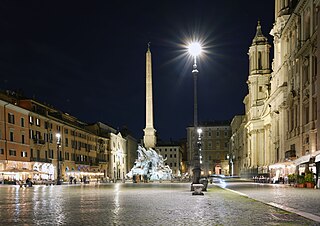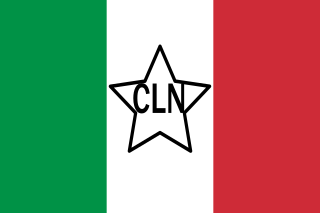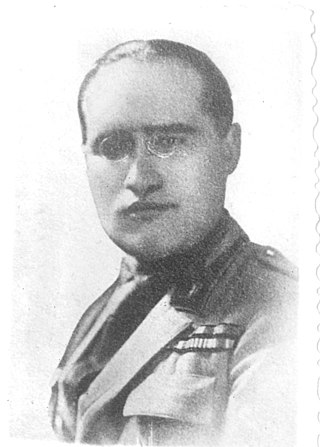
Piazza Navona is a public open space in Rome, Italy. It is built on the site of the Stadium of Domitian, built in the 1st century AD, and follows the form of the open space of the stadium. The ancient Romans went there to watch the agones ("games"), and hence it was known as "Circus Agonalis". It is believed that over time the name changed to in avone to navone and eventually to navona.

The Ardeatine massacre, or Fosse Ardeatine massacre, was a mass killing of 335 civilians and political prisoners carried out in Rome on 24 March 1944 by German occupation troops during the Second World War as a reprisal for the Via Rasella attack in central Rome against the SS Police Regiment Bozen the previous day.

The Italian resistance movement is an umbrella term for the Italian resistance groups who fought the occupying forces of Nazi Germany and the fascist collaborationists of the Italian Social Republic during the Second World War in Italy from 1943 to 1945. As a diverse anti-fascist movement and organisation, the Resistenza opposed Nazi Germany, as well as Nazi Germany's Italian puppet state regime, the Italian Social Republic, which the Germans created following the Nazi German invasion and military occupation of Italy by the Wehrmacht and the Waffen-SS from 8 September 1943 until 25 April 1945.
The Aventine Secession was the withdrawal of the parliament opposition, mainly comprising the Italian Socialist Party, Italian Liberal Party, Italian People's Party and Italian Communist Party, from the Chamber of Deputies in 1924–25, following the murder of the deputy Giacomo Matteotti by fascists on 10 June 1924.

Pietro Caruso was an Italian Fascist and head of the Rome police in 1944.

Ettore Ovazza was an Italian Jewish banker. He was an early financer of Benito Mussolini, of whom he was a personal friend, and Italian fascism, which he supported until the Italian racial laws of 1938. He founded the journal La nostra bandiera. Believing that his position would be restored after the war, Ovazza stayed on after the Germans marched into Italy. Together with his wife and children, shortly after the Fall of Fascism and Mussolini's government during World War II, he was executed near the Swiss border by SS troops in 1943.

The Palazzo Cesi-Gaddi war crimes archive or armoire of shame is a wooden cabinet discovered in 1994 inside a large storage room in Palazzo Cesi-Gaddi, Rome which, at the time, housed the chancellery of the military attorney's office. The cabinet contained an archive of 695 files documenting war crimes perpetrated on Italian soil under fascist rule and during Nazi occupation after the 8 September 1943 armistice between Italy and Allied armed forces. The actions described in the records spanned several years and took place in various areas of the country, from the southern city of Acerra to the northern province of Trieste and as far east as the Balkans; it remains unclear, to this day, how the archive remained concealed for so long, and who gave the order to hide the files in the immediate post-war period.

Benedetto Pamphili was an Italian cardinal, patron of the arts and librettist for many composers.

Temistocle Testa was an Italian Fascist activist and politician.

Liberation Day, also known as the Anniversary of Italy's Liberation, Anniversary of the Resistance, or simply 25 April, is a national holiday in Italy that commemorates the victory of the Italian resistance movement against Nazi Germany and the Italian Social Republic, puppet state of the Nazis and rump state of the fascists, during the liberation of Italy and the Italian Civil War during World War II. That is distinct from Republic Day, which takes place on 2 June and commemorates the 1946 Italian institutional referendum.
Events from the year 1944 in Italy.

Roberto Lordi was Brigadier General of the Regia Aeronautica, Gold Medal of Military Valour Recipient and Martyr in the Fosse Ardeatine Massacre.

The Museum of the Liberation of Rome is located in an apartment building at Via Tasso 145, Rome, close to the basilica of St. John Lateran. It records the period of German occupation of Rome in the Second World War and its subsequent liberation. The building housing the museum was used by the SS to torture members of the Italian Resistance in the first half of 1944.

The Brigate Garibaldi or Garibaldi Brigades were partisan units aligned with the Italian Communist Party active in the armed resistance against both German and Italian fascist forces during World War II.
The Clandestine Military Front was an organization of the Italian Resistance that operated in German-occupied Rome between September 1943 and June 1944. It consisted of some 2,300 men, largely Army officers who had gone into hiding after the German capture of Rome, such as Minister of War Antonio Sorice and Generals Roberto Lordi, Mario Girotti, Dardano Fenulli and Vito Artale. Its first leader was Colonel Giuseppe Cordero Lanza di Montezemolo, who after being arrested in January 1944 was replaced by General Quirino Armellini, in turn replaced by General Roberto Bencivenga in March 1944. Thirty-four of its members, including Colonel Montezemolo and Generals Lordi, Fenulli and Artale, were among the victims of the Fosse Ardeatine massacre.

Raffaele Aversa was an Italian soldier and Resistance member, most notable for having carried out the arrest of Benito Mussolini after his dismissal as Prime Minister of Italy on 25 July 1943.

Giuseppe Cordero Lanza di Montezemolo was an Italian soldier and Italian Resistance member.

Guido Leto was an Italian police official, head of the OVRA, the secret police of the Fascist regime, from 1938 to 1945. Throughout his career as a policeman he served under the Kingdom of Italy, the Italian Social Republic, and the Italian Republic.

Sabato Martelli Castaldi was an Italian Air Force general and a member of the Italian Resistance during World War II. He was executed during the Ardeatine massacre.
Giuseppe Pavone was an Italian general during the interwar period and World War II.

















